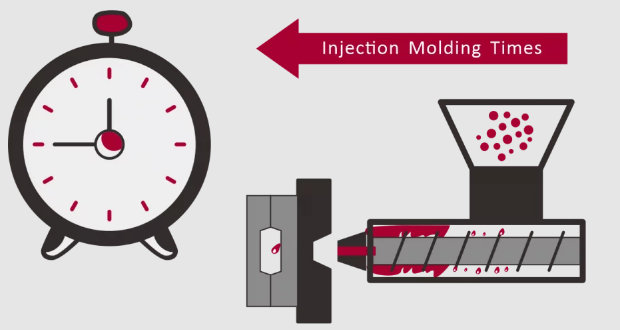
In injection molding, the cooling of the part is primarily influenced by the cooling time rather than the hold or cure time. However, hold (or packing) time and cooling time both play crucial roles in the overall cycle of the injection molding process. Here’s how each of these factors contributes to the cooling and quality of the final part:
Hold (or Packing) Time
- Function:
- The hold or packing time is the period during which additional material is packed into the mold cavity under pressure after the initial injection phase. This helps compensate for the shrinkage that occurs as the material cools and solidifies.
- Impact on Cooling:
- Density and Structure: Proper hold time ensures that the part has the correct density and that voids or sink marks are minimized. This indirectly affects the cooling by ensuring the part is uniformly filled and structurally sound.
- Dimensional Stability: Adequate hold time contributes to the dimensional stability of the part by ensuring that the material is well-packed and has minimal shrinkage during the cooling phase.
- Cooling Contribution:
- While hold time doesn’t directly cool the part, it ensures that the part is adequately packed, which helps in achieving consistent cooling and minimizing defects.
Cooling Time
- Function:
- Cooling time is the period during which the mold is closed, and the part inside the mold cools and solidifies to a temperature at which it can be ejected without deformation or damage.
- Impact on Cooling:
- Heat Dissipation: During cooling time, heat is dissipated from the molten plastic through the mold walls and into the cooling system (usually water channels) embedded in the mold.
- Solidification: The part transitions from a molten state to a solid state during this time. The rate of cooling affects the crystallinity, mechanical properties, and final dimensions of the part.
- Cooling Contribution:
- Direct Cooling: Cooling time is the primary factor that cools the part. Efficient cooling system design, including proper placement of cooling channels and use of conformal cooling, ensures rapid and uniform cooling.
- Cycle Time: Optimizing cooling time is essential for reducing overall cycle time and improving productivity.
Cure Time
- Definition: Cure time generally refers to the time required for chemical reactions to complete, such as in thermosetting plastics or curing of resins. In the context of thermoplastics (common in injection molding), cure time is not typically a significant factor.
[elementor-template id=”4330″]
Balancing Hold and Cooling Time
For optimal injection molding performance, it’s essential to balance hold time and cooling time:
- Sufficient Hold Time: Ensure that the hold time is long enough to pack the material properly and minimize defects like sink marks and voids.
- Efficient Cooling Time: Optimize cooling time to ensure the part solidifies adequately and can be ejected without damage. This involves designing an effective cooling system within the mold.
Practical Steps
- Analyze Part Design: Consider the part’s geometry and material properties to determine the optimal hold and cooling times.
- Optimize Mold Design: Implement efficient cooling channels and consider conformal cooling to enhance cooling efficiency.
- Adjust Machine Settings: Fine-tune hold pressure, hold time, and cooling time based on empirical data and simulation results to achieve the best balance.
- Monitor and Control: Use real-time monitoring systems to control and adjust cooling parameters during production.
Example
Suppose you are molding a part with thick sections prone to sink marks:
- Increase Hold Time: Ensure the hold time is sufficient to pack the material adequately, minimizing sink marks.
- Optimize Cooling Channels: Design the cooling system to provide uniform cooling, especially in thicker sections.
- Monitor Cooling Time: Adjust cooling time based on the part’s temperature and solidification requirements to ensure it can be ejected without deformation.
Conclusion
Cooling time is the primary factor that directly cools the part in injection molding, while hold time ensures the material is packed correctly to achieve dimensional stability and minimize defects. Balancing these two parameters is crucial for producing high-quality injection-molded parts efficiently.
Related Conten: Expert Large Plastic Molds Manufacturing
 DTG Mould Trade Process |
|
| Quote: | According to sample, drawing and specific requirement. |
|---|---|
| Discussion | Mold material, cavity number, price, runner, payment, etc. |
| S/C Signature | Approval for all the items. |
| Advance | Pay 50% by T/T |
| Product Design Checking | We check the product design. If some position is not perfect, or can not be done on the mould, we will send customer the report. |
| Mold Processing | Send report to customer once each week |
| Mold Testing | Send trial samples and try-out report to customer for confirmation |
| Mold Modification | According to customer’s feedback. |
| Balance Settlement | 50% by T/T after the customer approved the trial sample and mould quality. |
| Delivery | Delivery by sea or air. The forwarder can be designated by your side. |
 |
|

